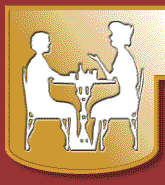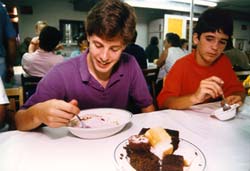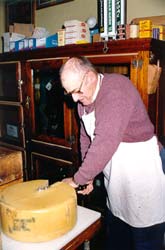

 What we eat and with whom; how we prepare and preserve our food-these help define our culture and ourselves. From the time we are small we connect various nationalities with specific food specialties: Italian lasagna, German sauerkraut and sausage, Greek baklava, and Chinese won ton soup. In fact the eating of certain foods help give people a feeling of unity with other members of their own culture; foodways are a visible badge of identity. For that reason, they are one of the most persistent of ethnic traits. Often families who have lived in a culture other than their own for generations and have become indistinguishable from their neighbors in terms of language, dress and occupation still consider "home cooking" to be the recipes brought by their grandparents from the old country.
What we eat and with whom; how we prepare and preserve our food-these help define our culture and ourselves. From the time we are small we connect various nationalities with specific food specialties: Italian lasagna, German sauerkraut and sausage, Greek baklava, and Chinese won ton soup. In fact the eating of certain foods help give people a feeling of unity with other members of their own culture; foodways are a visible badge of identity. For that reason, they are one of the most persistent of ethnic traits. Often families who have lived in a culture other than their own for generations and have become indistinguishable from their neighbors in terms of language, dress and occupation still consider "home cooking" to be the recipes brought by their grandparents from the old country.
In addition to everyday foodways, every culture has special holiday occasions which usually include the preparing and eating of food as part of the festivities. In the United States, family Thanksgiving dinners and July 4th reunions use food as a central point around which to build family identity. Similarly the church or community covered dish supper helps to draw a whole town together. In fact, sharing a meal is one of the universal ways of indicating fellowship. In times of sorrow our first thought is to take food to the bereaved, only partly because we think they may actually need it to feed visiting relatives. The casserole or cake we take to a grieving friend is also a way of acknowledging our commitment to our relationship with him or her.
 Because food is so closely related to our concepts of nurturing, food preparation and eating is an important time of apprenticeship-a time when new members of a family or community learn how to take their place as contributing members of the group. Children begin by watching their grandmothers, mothers and aunts (and more recently in our culture, fathers), then slowly, over the years, begin to help, absorbing not only the hands-on skills needed to roll a pie crust or stuff a turkey, but also the community values defining "good cook." Finally, the older generation surrenders pride of place to the younger, secure in the knowledge that the tradition will continue. More than food-related values are passed on during these sessions; they are also a time for retelling of family legends and establishing a communal response to events both within and outside the family. The listening child effortlessly learns his or her history and picks up the family and community morality.
Because food is so closely related to our concepts of nurturing, food preparation and eating is an important time of apprenticeship-a time when new members of a family or community learn how to take their place as contributing members of the group. Children begin by watching their grandmothers, mothers and aunts (and more recently in our culture, fathers), then slowly, over the years, begin to help, absorbing not only the hands-on skills needed to roll a pie crust or stuff a turkey, but also the community values defining "good cook." Finally, the older generation surrenders pride of place to the younger, secure in the knowledge that the tradition will continue. More than food-related values are passed on during these sessions; they are also a time for retelling of family legends and establishing a communal response to events both within and outside the family. The listening child effortlessly learns his or her history and picks up the family and community morality.
 Our families and communities do not exist in a vacuum. We are part of the natural world around us-more so in the North Country than in more urban areas-and our food traditions reflect that. Even though nationwide grocery chains bring out-fo-season fresh foods to our towns, the high cost of certain foods often prevents our taking advantage of this bounty. The diets of most people still depend very much on what is native to the area in which they live. In the North Country our short growing season puts many foods out of our reach. Most fruits, for example, prefer a warmer climate and earlier spring than we can offer. However, apples of many varieties thrive in our cold area, so they have become a staple of the North Country diet. The many dairy farms in the region provide a wealth of cheese-from cheddar so sharp it stings the mouth to the mild, rubbery deliciousness of fresh cheese curd. There are many who feel that a meal in the North Country is simply not complete unless it has cheese in it somewhere! Our warm early spring days and cold nights provide the perfect environment for the production of maple syrup. Like apples and cheese, syrup shows up constantly in the local diet. North Country cooks have been very inventive in discovering new ways to use these products, as well as the abundant game and fish native to our area.
Our families and communities do not exist in a vacuum. We are part of the natural world around us-more so in the North Country than in more urban areas-and our food traditions reflect that. Even though nationwide grocery chains bring out-fo-season fresh foods to our towns, the high cost of certain foods often prevents our taking advantage of this bounty. The diets of most people still depend very much on what is native to the area in which they live. In the North Country our short growing season puts many foods out of our reach. Most fruits, for example, prefer a warmer climate and earlier spring than we can offer. However, apples of many varieties thrive in our cold area, so they have become a staple of the North Country diet. The many dairy farms in the region provide a wealth of cheese-from cheddar so sharp it stings the mouth to the mild, rubbery deliciousness of fresh cheese curd. There are many who feel that a meal in the North Country is simply not complete unless it has cheese in it somewhere! Our warm early spring days and cold nights provide the perfect environment for the production of maple syrup. Like apples and cheese, syrup shows up constantly in the local diet. North Country cooks have been very inventive in discovering new ways to use these products, as well as the abundant game and fish native to our area.
The idea of depending primarily on local products is only part of traditional cookery. Another important aspect can be summed up in the old adage "Waste not, want not." This guiding principle is behind the cooking of all traditions and has led to the creation of such diverse dishes as bread pudding and head cheese. It also has contributed to the development of a great variety of methods of food preservation-pickling, salting, preserving in jams and jellies, freezing, and canning. Although different cultures emphasize different choices among these methods, the underlying principle never varies.
It has been said that "You are what you eat." Most often this phrase is used by mothers urging carrots onto unwilling offspring or dentists lecturing on the evils of candy and soda, but clearly the truth of the statement goes much deeper than its purely physical implications.
From Good Food Served Right: Traditional Recipes & Food Customs From New York's North Country
©2002 Traditional Arts in Upstate New York